The results of the XFL-USFL merger are the newly formed United Football League, aka the UFL. The UFL will begin play this spring as the latest venture into spring football in the U.S.
Three distinct XFL iterations have come and gone in the eyes of American football fans. One AAF, two UFLs, and two USFLs have all existed at some point in history. After trying to run independently last season, the decision was made to combine the two latest spring leagues. The XFL-USFL merger is the result.
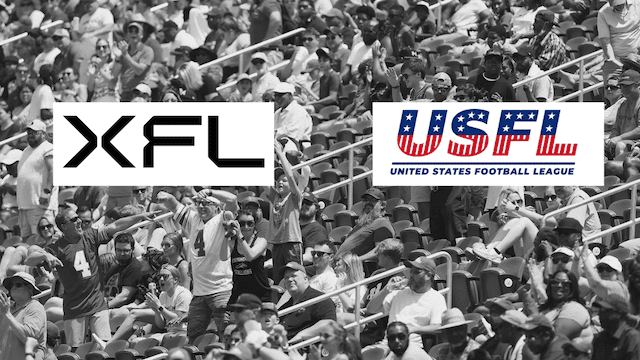
The XFL-USFL merger also resulted in the revival of the UFL name. Training camp for the third UFL, which is owned equally by Fox Sports and the previous XFL 3.0 investors, began on Saturday, Feb. 27, in Arlington, Texas.
Beginning on March 30, the league’s eight teams will compete in a 10-week season without any bye weeks. The league has a number of advantages over its predecessors, including substantial financial support, a number of national broadcast partners, and a combination of earlier templates.
EDITOR’S CHOICE: HOW TO BET ON FOOTBALL
Why the XFL-USFL Merger Could Work
The CEO and president of the new UFL is Russ Brandon. He believes that this XFL-USFL merger will result in a league that will endure long beyond his lifetime.
“Having one focused league is the right thing to do for spring football,” stated Brandon. “We all have a strong sense of confidence that this league will endure far beyond our lifetimes.”
Brandon, a veteran NFL executive with the Buffalo Bills, joined the XFL for the 2023 season. He has a ton of NFL experience. The executive vice president of football operations is Daryl Johnston, a former All-Pro RB with the Dallas Cowboys. Johnston was the former head of the USFL’s front office. Between the two, this XFL-USFL merger has tons of NFL front office experience.
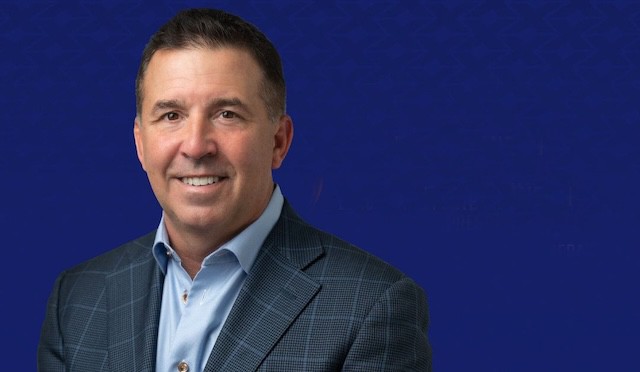
“We’re going to be a much, much more talented league with a lot more depth at the critical positions,” Johnston stated. “I believe that our coaching staffs will be more capable. Eight teams from the USFL and eight from the XFL are combined to form eight. You are bringing into the UFL family the best coaches and players available.”
With the XFL-USFL merger, the eight teams from each league were combined into eight total teams that will compete in the new UFL.
UFL Training Camp
All eight teams in the UFL will report to the league’s headquarters in Arlington, Texas, for training camp. Those training camps are underway already. Each team took a roster of 75 players into camp. Rosters will be reduced to 50 once the regular season starts.
During the regular season, those Arlington-based facilities will remain in use for team practices. The UFL will follow the XFL model used in 2023. The new UFL teams will only travel to their home markets for games.
XFL-USFL Merger – New Teams
As mentioned, the old XFL and the old USFL each had eight teams. Four former XFL teams and four old USFL teams will make up the new league created by the XFL-USFL merger. The only market where the two leagues overlapped was Houston. The UFL chose to rename the USFL Houston franchise after the XFL Houston team.

The following teams, their home stadiums, and head coaches are listed below. They are broken up into the new UFL’s two divisions – the USFL Division and the XFL Division.
USFL Division
The USFL Division has four teams. Each is listed below with its head coach and the stadium where they will play their home games.
- Birmingham Stallions (Skip Holtz, Protective Stadium)
- Houston Roughnecks (Curtis Johnson, Rice Stadium)
- Memphis Showboats (John DeFilippo, Simmons Bank Liberty Stadium)
- Michigan Panthers (Mike Nolan, Ford Field)
XFL Division
The XFL Division also has four teams. Each is listed below with its head coach and the stadium where they will play their home games.
- Arlington Renegades (Bob Stoops, Choctaw Stadium)
- D.C. Defenders (Reggie Barlow, Audi Field)
- San Antonio Brahmas (Wade Phillips, The Alamodome)
- St. Louis Battlehawks (Anthony Becht, The Dome at America’s Center)
XFL-USFL Merger – The Players
It’s always interesting to see what types of players end up playing spring football. Hundreds of players have been sent to NFL tryouts, offseason practices, training camp practices, and/or regular-season rosters by the AAF, XFL, and USFL.
Several of those players, such as Dallas Cowboys returner KaVontae Turpin, Atlanta Falcons quarterback Logan Woodside, and Los Angeles Chargers tight end Donald Parham Jr., were former spring league football players still active on an NFL roster in 2023.
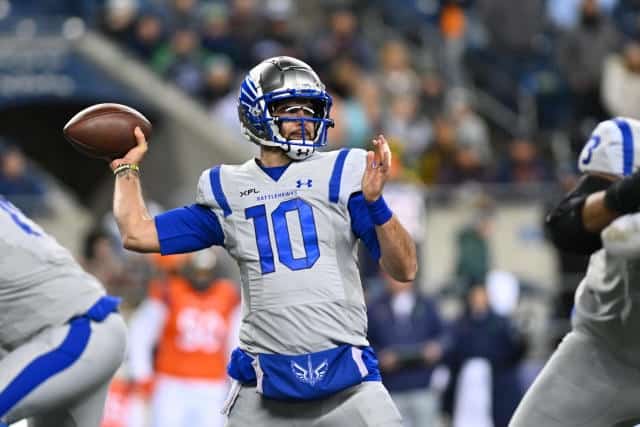
However, Johnston expressed surprise at the number of spring football players in the USFL, XFL, and AAF who do not necessarily see an NFL opportunity. The XFL-USFL merger will definitely create some NFL opportunities for certain players. However, there are those that are perfectly content with playing in the UFL.
“I’ve expected the majority of our players [in past seasons] would be like, ‘I’ve got to get my chance to get back up there to the NFL,'” Johnston. “However, you begin to notice that many of the guys are content that their NFL career is over even though they enjoy the camaraderie of the locker room. They enjoy the daily grind.”
UFL Players You May Recognize
There are a few players with NFL name recognition who are on UFL training camp rosters. One such play is Wayne Gallman, a former running back for the New York Giants who is assigned to St. Louis.
The new XFL-USFL merger also hopped on the social media bandwagon in an effort to sign YouTube sensation Donald De La Haye. The former UCF kicker is known online as “Deestroying” and is now a member of the San Antonio franchise.
WELCOME @corral_matt 👋👋 pic.twitter.com/5qybZM37cD
— B2B CHAMPIONSTALLIONS 🏆🏆 (@USFLStallions) February 27, 2024
There will be a significant amount of personnel turnover in the upcoming weeks. Much of that turnover will come at the quarterback position. Quarterback talent is typically used to evaluate leagues. To that end, a combination of former NFL backups and spring league veterans have been targeted by the UFL.
You may recognize names like A.J. McCarron of St. Louis, Matt Corral of Birmingham (see above), Danny Etling of Michigan, and Tom Flacco from San Antonio. If Flacco sounds familiar, it’s because he is the brother of former NFL quarterback Joe Flacco. Jordan Ta’amu (D.C.) and Luis Perez (Arlington), the quarterbacks from the XFL championship game in 2023, will also be back.
Quarterback Pay Scale
Some of the spring football leagues tried to attract better quarterback talent by paying players at the position much more than other players in the league. Johnston stated that the UFL had decided against paying quarterbacks above-scale salaries. Their pay will be in line with others in the UFL.
According to their agreement with the United Football Players Association, a union the UFL has acknowledged and negotiated with, UFL players get $5,500 per game week. Quarterbacks will earn the same amount.

The league wants to exercise financial restraint. The UFL also understands the argument that can be made for paying quarterbacks more than other positions. As the XFL-USLF merger grows, paying quarterbacks more is something that could be a future possibility. For now, all players will be paid the same.
XFL-USFL Merger – Speaking of Money
Eric Shanks is the CEO of Fox Sports and, in his position, represents the interests of 50 percent of the UFL ownership. The other half is owned by Dany Garcia, Dwayne “The Rock” Johnson, and Gerry Cardinale of RedBird Capital Partners.
Disney/ESPN and Fox Sports are broadcast partners for the new league. Every one of the 43 UFL games will be streamed on Fox Sports app or ESPN+, and televised on ABC, Fox, ESPN, FS1, or ESPN2.
The regular season will begin on March 30 and continue through June 2. Four teams, two from each conference, will make the UFL postseason. The playoffs will start on June 9. The first UFL championship game will take place on June 16 in a city yet to be determined.
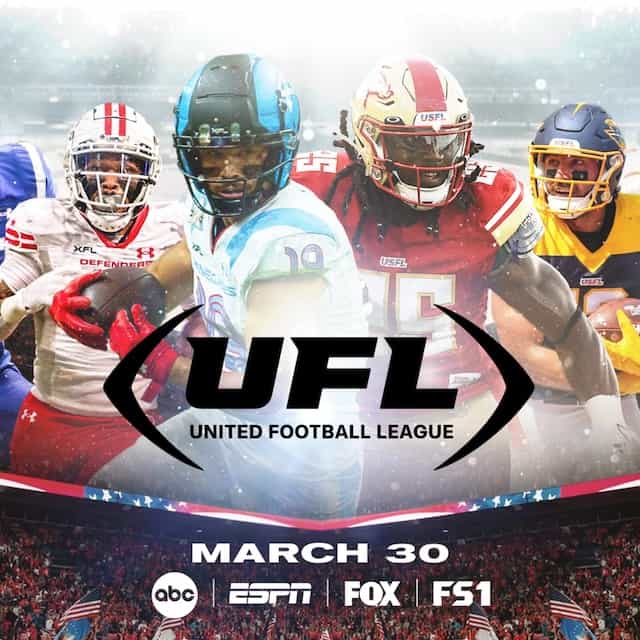
UFL players will be eligible for additional compensation as well. In addition to their weekly salary during the regular season, all players earn $850 per week during training camp and they are eligible to receive up to $1600 per month ($400 per week) in housing allowances.
There are additional Player of the Week incentives ($1,000), All-UFL ($2,500), Player of the Year ($5,000), and league MVP bonuses ($7,500). Players will also be compensated for media appearances and speaking engagements.
UFL Opening Week Schedule
The 2024 UFL regular season will begin on Saturday, March 30, with two games, both of which will be broadcast by Fox. Arlington will play Birmingham at 1 p.m. and the Michigan Panthers will take on the St. Louis Battlehawks at 4:30 p.m.
Opening week play continues on Sunday, March 31, with two more games. Both Sunday games will be televised by ESPN. The San Antonio Brahmas will face the D.C. Defenders with kickoff set for noon.
The Houston Roughnecks will visit the Memphis Showboats in the late game. That one will start at 3 p.m. ET.
For ten straight weeks, the UFL will play on Saturday and Sunday. The top teams in each division will compete in their respective conference championship. The conference champs will then meet in the UFL championship game on June 16.
XFL-USFL Merger Produces New Rules
The most notable rule innovation from the recent spring football movement involves the kickoff. The NFL changed their rules on kickoffs so that members of the coverage team must now line up within a yard from the 35-yard line, where kickoffs occur.
The XFL had a unique kickoff where 10 players on each team were lined up five yards apart. Only the kicker and the kick returner were not lined up within five yards of each other. The idea was to reduce the number of high speed collisions and potentially reduce the number of concussions.
The Rock has revealed the XFL and USFL have successfully merged, forming the United Football League (UFL). The kickoff for this league is set for Saturday, March 30. pic.twitter.com/ar98XeN60b
— IG: NFLPreme (@premefootball) December 31, 2023
The UFL, the result of the XFL-USFL merger, will go back to the traditional kickoff used in the NFL. The difference, however, will be that kickers will put the ball in play at the 20-yard line. This will likely limit and possibly even eliminate touchbacks in the UFL. This is similar to what the USFL did in 2022 and 2023.
The XFL’s model only allowed the kicker and kick returner to move up until the ball was fielded or remained on the ground for three seconds. Ninety percent of all kickoffs in the old league were returned.
UFL Extra Point Rules
One of the different ideas that comes out of the XFL-USFL merger is in relation to the points attempted after a touchdown. Traditional college and NFL rules allow teams to attempt a point after touchdown (PAT) in two ways. One is a kick from scrimmage. In the NFL, the ball is now placed at the 15-yard line for a kick after touchdown, which results in one point if successful.
If an NFL team wishes to try for two points, the ball is placed at the two-yard line. If successful, the team is awarded two points. In college football, the two-point try comes from the three-yard line.
The new UFL will adopt the XFL’s old point-after-touchdown model. There are three options for a team that scores. Teams can try for one point from the two-yard line or two points from the five-yard line. The final option is a three-point PAT that begins from the 10-yard line. Each PAT option involves a scrimmage play. There will be no kicking options after a touchdown.
Additional XFL-USFL Merger Rules
The new UFL will also institute some new rules that will differ from traditional NFL and college football rules. One involves the onside kick. The NFL is currently reviewing its onside kick rules. The UFL will approach the situation much differently.
The traditional onside kick can be attempted at any point in a game. A second option is available in the fourth quarter of a game. Instead of an actual onside kick, a kicking team will have the option of converting a 4th-and-12 scrimmage play from its own 28-yard line. If successful, the “kicking” team will maintain possession of the football.
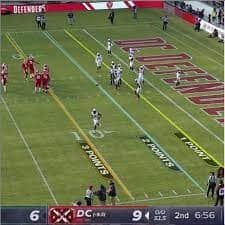
One interesting rule in the UFL calls for replay review at any time. Replay officials have the authority to stop a game and review a play. Any play in a game’s final five minutes can be reviewed, not just the plays included on the UFL’s list of reviewable situations. In addition, coaches receive one challenge per game.
To promote fourth-down attempts and reduce coffin corner kicks, the league will spot any ball kicked past an opponent’s 25-yard line that goes out of bounds at the 25-yard line.
The league will also use a best-of-three overtime format. Should teams be tied at the end of regulation, they will get alternating chances to score from the opponent’s five-yard line. Kicks are not permitted.
XFL-USFL Merger FAQs
What is the new spring football league called?
The XFL-USFL merger resulted in a new spring football league that will take the name United Football League. The new league will keep the XFL and USFL names for its two divisions. There will be four teams in each division.
When does the new UFL season start?
The XFL-USFL merger created the UFL, which will begin play on Saturday, March 30. For ten consecutive weeks, teams will play on Saturdays and Sundays in the regular season. The top two teams in each division will make the playoffs.e new UFL season start?
What rules are different in the UFL?
The UFL will incorporate some of the rules used by its predecessors, the USFL and the XFL. The league will keep the XFL’s three-tiered option for points after a touchdown. Teams have the option to go for 1, 2, or 3 points. Also, teams will have a second option for an onside kick in the fourth quarter. They must successfully convert a 4th-and-12 play from their own 28-yard line to maintain possession.
What are the teams in the UFL?
The XFL and USFL each had eight teams. There will be eight teams total in the UFL. After the XFL-USFL merger, D.C., Arlington, San Antonio, and St. Louis from the XFL will be in the new UFL. The USFL franchises to make the cut were Birmingham, Memphis, and Michigan. Houston had a franchise in both leagues and the Roughnecks will remain in the UFL.
Why did the XFL-USFL merger take place?
The two leagues thought success for both leagues would be greater if the two leagues came together and built on what each separate league did best. The XFL-USFL merger takes the best of both leagues and combines it into one spring football league that has a better chance for success.





